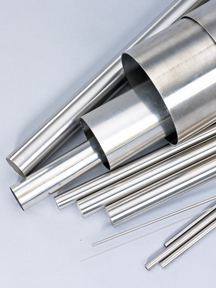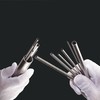AUSTENITIC, MARTENSITIC, FERRITIC STAINLESS STEEL
Featured Product from Eagle Stainless Tube & Fabrication, Inc.

AUSTENITIC, MARTENSITIC, FERRITIC STAINLESS STEEL
Stainless steel is the generic name for the widely popular family of corrosion resistant metal alloys. Though there are a number of different stainless steels, austenitic vs. martensitic, for example, the one commonality that they all share is a 10.5% minimum chromium content. Once chromium is alloyed to steel it forms a protective film on the steel surface, preventing any contact with oxygen. Depending on the material needs, other elements such as nickel, molybdenum, or titanium can be added to improve corrosion resistance and to provide additional necessary properties that can enhance performance of the metal.
Stainless Steel Types
There are several families of stainless steels. The three most popular are austenitic, ferritic, andSeveral stainless steel tubes piled together on a white background martensitic, the names of which are derived from their respective steel characteristics. Within each family there are numerous numerical grades or compositions of stainless steel, i.e., the 300 series or 400 series that refer to its alloy composition and the mechanical properties for various environments and applications.
Austenitic Stainless Steels
Austenitic stainless steels account for more than 70% of stainless steel production, with type 304 the most common grade of stainless steel used. Basic composition of austenitic steels is 18% chromium and 8% nickel. However, type 316 contains 16% to 18% chromium and 11% to 14% nickel which make it exceptional for applications in corrosive environments. Nickel content is higher in austenitic than ferritic and martensitic stainless steels. The steel is non-magnetic, is hardened significantly by cold-working and is known for its high corrosion resistance, formability, weldability, and other fine mechanical properties. The austenitic grades are found in the 200 series and 300 series, and are widely used for cookware, food and beverage equipment, processing equipment, and also in the automotive industry, chemical processing,, and the pulp and paper industry.
Ferritic Stainless Steels
Classified in the 400 series grade, ferritic stainless steels account for approximately 20% of the stainless steel market. They consist of a lower carbon with varying chromium content between 10.5% and 18% and, like martensitic stainless steel, it contains no nickel. Ferritic steels are magnetic, have good ductility, formability and, like austenitic stainless steels, are not heat-treatable. They are highly resistant to stress corrosion cracking, offer very good tensile-property stability and have better thermal fatigue resistance, lower thermal expansion, and higher thermal conductivity than austenitic grades. The most common ferritic grade is type 430, known for its high corrosion resistance to nitric acid, sulfur gases, and many organic and food acids. Other grades are type 405, 409, 434, 436, 442, and 446. In general, ferritic steels are used in elevated-temperature applications such as exhaust systems for vehicles. Other applications for ferritic stainless steels include petrochemical components, automotive trim, heat exchangers, furnaces, appliances and food equipment to name a few.
Martensitic Stainless Steel
Martensitic stainless steels contain 12% to 18% chromium with a relatively high carbon content compared to other stainless steels. These grades of stainless steel are straight chromium with no nickel. They are characterized by high strength, have magnetic properties, acceptable corrosion resistance, and can be hardened through heat treatment. Martensitic are best suited for applications that require hardness, strength, and wear resistance. This grade is in the 400 series, including types 410, 410S, 4141, 416, 420, 431, and 440. General-purpose martensitic stainless steel is listed as grade 410. Grade 420 is used for surgical cutting tools. Martensitic stainless steels are used in cutlery, surgical and dental instruments, springs, scissors, industrial blades, aerospace components and other general engineering components.
Top 10 Guidelines for Ordering Stainless Steel Tubing
This guide walks you through what to know when ordering stainless steel tubing and related products. The right tubing can last the lifetime of your product
DOWNLOAD OUR CATALOG
Your Primary Source for Stainless Steel Products
Download or request a hard copy of our updated design and manufacturing guidebook, offering valuable technical information to help you select the proper size and material composition for your unique needs. As a top stainless steel tube manufacturer we offer machining, welding, cutting, assemblies and bending while meeting or exceeding GMP and ASTM standards.
Follow us on:
Watch>>Eagle Stainless Overview
For an overview of our fabrication services please see this pdf download.
Custom Tubing Designed for Your Needs
Making a difference in your design… from simple tubing to complex designs.
At Eagle, there’s nothing more important than producing a customized solution which exceeds our clients’ expectations and satisfies the unique specifications of their application. Our expertise with stainless steel custom tubing gives us the ability to help you design the product that will fit your project.
Complex designs need more than just stainless steel custom tubing. Secondary operations such as cutting to precision lengths, CNC and EDM machining, laser welding, bending, and precision grinding can transform a simple tube into just the part you need for your design.
We welcome the opportunity to share our expertise in developing product concepts and helping you solve your engineering problems. With decades of experience in the metals industry, you can count on Eagle as a resource for designing and fabricating your metal products.
Eagle Stainless Tube & Fabrication Inc.
Eagle Stainless Tube & Fabrication Inc.supplies stainless steel tubing to the medical, aerospace and high tech industries. Stainless steel, nickel alloys, aluminum, and titanium.
- Cut to length
- Precision machining
- Laser cutting & welding bending
- Electro-polishing and passivation.
- Re-draw to specialty & millimeter sizes in both round, square and rectangular.
- Grinding to precision tolerances
- Assemblies




